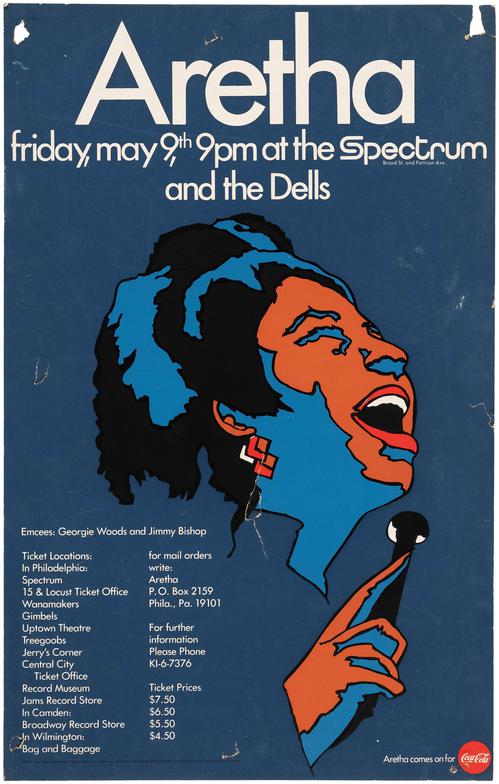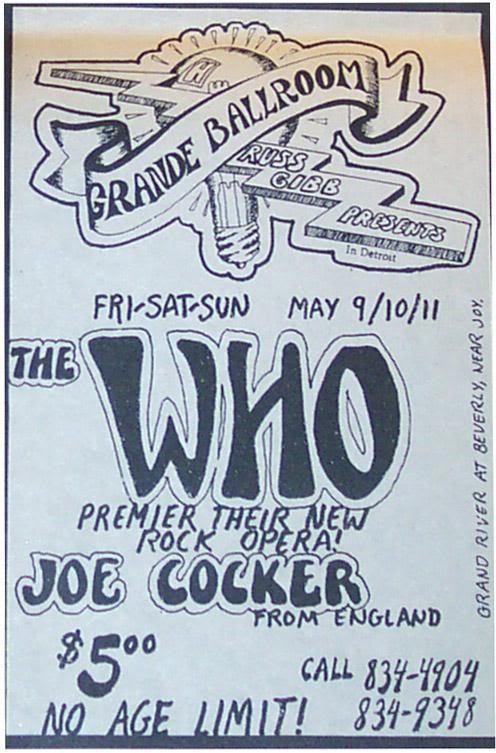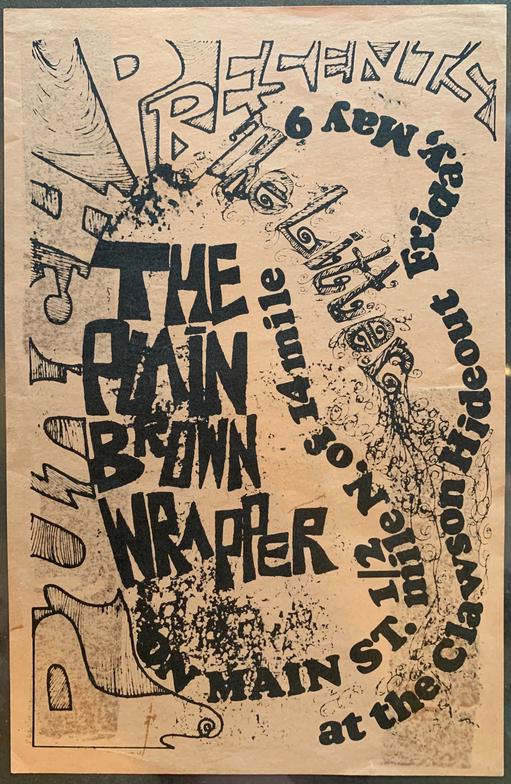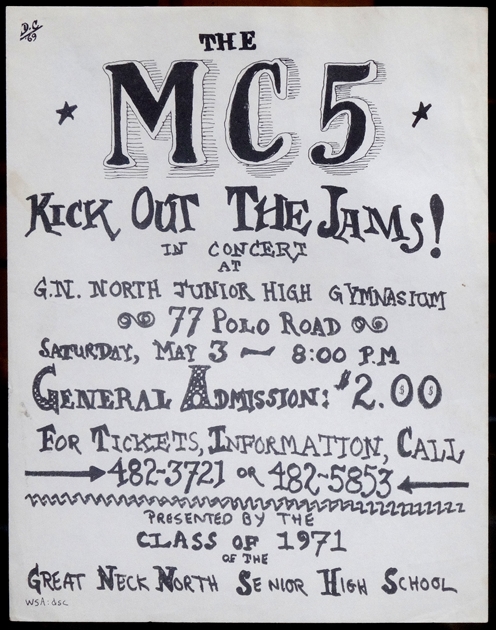Splatt Gallery
Double click here to add text.
Splatt Gallery's History of Michigan Concert Posters
Volume Five - 1969 - Page Nine
Given the nickname “Cubby” as a precocious ten year-old drummer on The Mickey Mouse Show, Michael Koda switched from drums to guitar and formed a band called the Del-Tinos at Manchester High School outside of Ann Arbor, Michigan, releasing a couple of singles in 1963 and 1965. Years after the Del-Tinos broke up, Koda met Michael Lutz from the band, The Talismen, at Jools Holland’s Discount Records and together they formed the band Brownsville Station.
Their earliest known show was at the concert at the Ice Palace in Livonia on April 19, 1969, which is thought to actually be their second or third show ever The next earliest-known show was at the Something Different teen club in Southfield, Michigan on May 9, 1969, followed by a show at the Roostertail in Detroit on May 11th, and the Hideout #3 in Clawson, Michigan on May16th, after which they would begin their many festival appearances, starting with the 1st Annual Rock & Roll Revival at the Michigan State Fairgrounds in Detroit on May 31st.
The Del-Tinos – Nightlife (1965)
https://www.youtube.com/watch?v=lGHHwJyNlxM
***********************************************************
Two ads for two shows by the Jimi Hendrix Experience, in Charlotte, North Carolina on May 9, 1969, and in Baltimore, Maryland on May 16th. Both shows were opened by Cat Mother and the Buddy Miles Express, featuring Detroit guitarist Jim McCarty.
Poster for Aretha Franklin in Philadelphia, May 9, 1969 which uses the image from her 1968 Coca-Cola ad, as the concert is sponsored by the soft drink company.
The 136th weekend at the Grande Ballroom, May 9-11, 1969 featured Carl Lundgren’s 27th (and final) poster for the venue. You can see that Carl was still in comic book mode, having just finished months of work on Tales from the Ozone #1 and hanging around with Robert Crumb.
The Who and Joe Cocker performed all three nights, with support by Maend and Mixed Generation.
These shows were famously the first time that The Who performed their rock opera Tommy in the US, and while all of the eyewitness accounts that we’ve seen report that it was fantastic, a majority of them also claim that the real highlight, however, was Joe Cocker, in his first Michigan appearances.
With some downtime between the end of The Yardbirds and the start of Led Zeppelin, the guitar player on the studio recording of “With a Little Help from my Friends” was none other than Jimmy Page. Cocker’s touring band, the Grease Band, were the core group for the recording of “Jesus Christ Superstar” and went onto even bigger collective and individual fame.
Joe Cocker – With a Little Help from my Friends (1968)
https://www.youtube.com/watch?v=6waXtxosJ4A
Double click here to add text.
We’re beginning to find posters like this, with an artist photo, titled “Live” at The Grande. We believe these may have been issued shortly after the shows, and may be actual live shots taken from the shows. This one is for Joe Cocker at the Grande Ballroom, May 9, 1969, when he opened for The Who’s US premier of Tommy, and is credited to Adams/Haron.
The newspaper ad for The Who at the Grande Ballroom, May 9-11, 1969, again featured the lightning bulb logo by Dave Baker, and pointed out that the band would premier their new rock opera. The world-wide premier of Tommy had occurred only one week earlier in London, England. The Grande Ballroom in Detroit was the first performance in the USA.
Nice poster for a high school dance in Garden City, Michigan, May 9, 1969, made by (presumably) a student named Debi (“a City Tea Productions”), otherwise an unknown artist.
When we last saw Little Richard, it was at the first "death of rock and roll", the crash-and-burn that ended the 1950's with Chuck Berry in jail, Elvis in the Army, Buddy Holly in the grave, Jerry Lee Lewis in hot water, and DJ's Alan Freed and Mickey Shorr driven off the radio in the payola scandal, and Little Richard entering the ministry, renouncing the evil rock and roll lifestyle. Little Richard's self-imposed exile from the secular world lasted a couple of years, during which he recorded and performed exclusively gospel music, but in 1962 a promoter in England informed him that his record were still selling quite well in the UK and convinced him to come over for a tour.
The opening act, Sam Cooke, did not make it in time for the tour's first show, Little Richard performed his gospel set and left the audience somewhat bewildered and underwhelmed. The next night, Cooke's performance ignited the crowd and taking quick notice, Little Richard had band leader Billy Preston re-tool the set with the old hits before Cooke had even finished, and with the cork out of the bottle, Little Richard killed it that night and all the subsequent nights of the tour, driving the audiences wild and generating headline press. A record producer in Liverpool, Brian Epstein, saw an opportunity to promote his newly-recorded band, the Beatles, and managed to get them on the bill for a number of tour dates, during which time Little Richard gave the Beatles, and Paul McCartney in particular, an invaluable tutorship. A few weeks after the tour ended, Little Richard, back in the states, received a plea to come back to England to pump life into a flagging tour by the Rolling Stones, he became the new headliner and once again triumphantly conquered the British audiences and ushered another young British rock group towards stardom. A number of high-profile TV appearances followed and once again, Little Richard was at the top.
Returning again to the US, Little Richard re-united with his original touring band, the Upsetters, whom, as we saw, had been picked up by Detroit’s Little Willie John after Little Richard had departed for the ministry. In late 1964, the Upsetters hired a journeyman guitar player named Maurice James who had previously played in the Isley Brothers band under his real name, Jimmy Hendrix. Hendrix loved Little Richard’s flamboyant fashion sense and showmanship, and for a while the two of them shared on-stage antics until the point that Little Richard began to feel up-staged. That, combined with Hendrix’s poor work ethic and tardiness, caused him to be fired from the band, but not before recording some tracks together in early 1965.
Little Richard’s popularity began to decline after this peak, the gospel audience felt betrayed and angered over his increasingly wild image, the rock audience began to move on to newer things, and four years later, long after the British Invasion and the Summer of Love had come and gone, Little Richard was reduced to playing small nightclubs, such as Vertigo West in Detroit, where he held a two-week-long engagement, performing fifteen shows May 9-25, 1969.
Little Richard – I Don’t Know What You Got (but it’s got me) (1965)
https://www.youtube.com/watch?v=6PIp4E9E6YI
High school students were becoming formidable concert promoters, as we’ve already seen in a number of posters, with fairly large-name acts being booked for school dances, sometimes with a connection to promoter Mike Quatro, as with this May 10, 1969 show by the Amboy Dukes and Frut of the Loom at Denby High School on the east side of Detroit.
The Amboy Dukes, at this point had played major venues around the country including the Fillmore East, the Boston Tea Party, the Electric Factory in Philadelphia, the Kinetic Playground in Chicago, and the Atlanta Municipal Auditorium, yet they were still open to playing a high school dance at home. They probably never forgot that they had played at the most famous high school dance of all time in the area when they had opened for The Who at Southfield High School in November, 1967.
This poster, like the others we’ve seen, was most likely made by a student artist, this one is signed by an unknown artist “REWS”.
Newspaper ads for Janis Joplin with Country Joe & the Fish and Teegarden & Van Winkle, at Cobo Arena in Detroit on May 10, 1969, her final Michigan appearance.
Terry Sharbach had been making posters for Grandmother’s in East Lansing, Michigan on a weekly, sometimes near daily, basis for about a year-and-a-half since the club’s opening in January, 1968. We’ve showcased about thirty or forty so far, and there’s this one from May 11, 1969.
The Cryan Shames from Hinsdale, Illinois, sure had a way with names. Starting their band as The Travelers, each of the members had quirky nicknames, Toad, Stonehenge, Grape, and Hook (who had a hook for the left hand he was born without). Learning that there was another local band called Tommy & the Travelers, they had to change their band name. First they tried to recruit Tommy, whose last name Krien sounded like “cryin’”, and when he refused the offer, Hook replied. “Well, that’s a cryin’ shame” and invented a new spelling for a quirky band name.
Their first album was mainly cover songs and they scored a hit with their version of “Sugar & Spice”. On their second album, they switched up their style, trading the jangly pop for psychedelic rock, and on their third album, they changed style again, leaning towards a jazzy prog-rock.
Here’s examples from the psych and prog records, “Sugar & Spice” is just too sticky sweet for this.
The Cryan Shames – The Sailing Ship (1968)
https://www.youtube.com/watch?v=qwuWlRn9Esk
The Cryan Shames – Greenburg, Glickstein, Charles, Smith & Jones (1969)
https://www.youtube.com/watch?v=dRy4EGN7X6E
A newspaper ad with Detroit Tigers pitcher Denny McLain performing on the organ at the Killarney Supper Club in Windsor, Ontario, Canada on May 12, 1969.
A fifth poster by artist Mary Partridge, in collaboration with Phil for The Cave in Lake Orion for the weekend of May 9, 1969.
An interesting poster by an unknown artist for Punch Andrews’ Hideout #3 in Clawson, Michigan, May 9, 1969, with Plain Brown Wrapper and The Litter from Minneapolis.
A pair of ads for a show by Stevie Wonder at the Finch Fieldhouse in Mount Pleasant, Michigan on May 7, 1969.
Poster for Alice Cooper in Colorado Springs, Colorado on May 7, 1969.
Newspaper ads in the East Village Other newspaper for the MC5 at Ungano’s in NYC, May 6-8, 1969.
Illustration by Phil Frank for an appearance by Harvey Scales & the Seven Sounds at Grandmother’s in East Lansing, Michigan, May 7, 1969. Notice the reduced cover charge for girls.
Known as Milwaukee’s “Godfather of Soul”, Scales was the co-author of the song “Love-It is”, we’ve previously posted the version of this song by the Canadian band Mandala, it would later be also covered by the J. Geils Band.
Scales’ greatest success will come later as the co-author of the 1976 Johnnie Taylor hit “Disco Lady”, the first-ever platinum single, selling two million copies. The video link is the band’s best-seller, “Get Down” which was backed by “Love-It is”.
Harvey Scales & the Seven Sounds – Get Down (1967)
https://www.youtube.com/watch?v=2rNykcBphd8
A full-page record company ad for the album by Hank Williams Jr. recorded at Cobo Hall in Detroit, Michigan on May 4, 1969.
Terry Sharbach illustration for an appearance by the band Marblecake at Grandmother’s in East Lansing, Michigan, May 6, 1969. Hailing from Kent, Ohio, Marblecake included drummer Joe Vitale, who would later join Ted Nugent’s Amboy Dukes, Joe Walsh’s Barnstorm, Crosby, Stills & Nash, and the Eagles, among others.
Chuck Berry was added to Terry Sharbach’s growing gallery of caricature portraits when he played at Grandmother’s in East Lansing, Michigan, May 4, 1969, backed by his local favorites, The Woolies. Upcoming shows listed at the bottom were the Cryin’ Shames, Aorta, BB King, and 3 Dog Knight (sic).
Newspaper ad for Johnny Cash and Hank Williams Jr. at Cobo Arena in Detroit, Michigan, May 4, 1969. The ad mentions that Hank’s performance would be recorded for an upcoming album titled “Hank Williams Jr. Live and In Person at Cobo Arena”, and sure enough, with a slight change to the title, it was.
Hank Williams Jr. – Live at Cobo Hall Detroit (album) (1969)
https://www.youtube.com/watch?v=3O8S61HA7kM&list=PLa87PXxmPasqY1rGAvgyeN5Xs0JMdnLP4
William Aronstein, a high school student in Great Neck, New York, and huge MC5 fan, wrote a letter to Trans-Love Energies, inviting the band to play at his school. Much to his surprise, he got a letter back from John Sinclair, offering the date of May 3, 1969. William made the poster for the show and arranged the use of the Junior High Gymnasium. Right up until the morning of the concert, some school officials familiar with the reputation of The Five tried to prevent the show, but finally acquiesced with the promise that they would be watching out for any profanity. Knowing the band’s set list, William timed it so that the officials were upstairs counting the money when the KOTJMF moment happened.
A Philips Records company ad for the first world tour by the French orchestra leader Paul Mauriat, with a concert at the Masonic Temple Auditorium in Detroit, Michigan, May 3, 1969. His instrumental version of the song “Love Is Blue” held the #1 spot on Billboard magazine’s Hot 100 Chart for five weeks in early 1968, and ended up as their #2 song for 1968.
The Paul Mauriat Orchestra – L’amour est blue (Love is Blue) (1968)
https://www.youtube.com/watch?v=XB_G68H67hY
High school student William Aronstein lucked out in getting the MC5 to play at his school in Great Neck, New York, because in those days you could write a letter to your favorite band and have them show up, and because the MC5 were scheduled for a week of shows in New York City.
Following the Great Neck High School stop-over, they played three nights at Ungano’s in NYC, a show for The Temple Free Press in Philadelphia, and this benefit for the Liberation News Service back in NYC, at the Hotel Diplomat with Children of God on May 13, 1969. Poster artist unknown.
Variation of the poster for the Liberation News Service Benefit with the MC5 and Children of God at the Hotel Diplomat in NYC on May 13, 1969.
Terry Sharbach’s second of three different illustrations of Baby Huey, this one for a show on May 14, 1969 at Grandmother’s in East Lansing, Michigan.
A neat little ad by an unknown artist for a concert by Savage Grace and the Red, White & Blues Band at Wayne State University in Detroit, Michigan on May 15, 1969.
A full-page Discount Records ad in the May 16, 1969 issue of the Berkeley Barb newspaper in Berkeley, California with the debut album by Alice Cooper, “Pretties For You”.
“Alice Cooper Does Whatever It Does on Straight Records”, and Frank Zappa thinks it’s “Bizarre”!
Poster for the Parliaments at Sacred Heart University in Fairfield, Connecticut, May 16, 1969. The poster still references their 1967 soul hit “(I Wanna) Testify”. Boy, was this audience in for a surprise.
A cartoon by Doug Huston in the May 16, 1969 issue of the State News newspaper in East Lansing, announcing the addition of cartoonist Paul Conrad to the paper, while assuring readers that cartoonist Phil Frank would continue to remain. The cartoon illustrates the local Grand Trunk Railroad, which served as the inspiration for the band name of the Grand Funk Railroad.
Poster/handbill by an unknown artist for a show at Cooley High School in Detroit, Michigan, May 16, 1969, called Ubald’s Ball, featuring Teegarden & Van Winkle, Red, White & Blues Band, Third Power, Savage Grace, and Train.
Record company ad for the Incredible String Band with a concert date for Ford Auditorium in Detroit, Michigan on May 16, 1969. This appears to be the only Michigan appearance for the band from Scotland, it is missing in the database, but does appear on other tour websites.
A Capitol Records ad in the May 16, 1969 issue of the Chicago Kaleidoscope newspaper with the second album by SRC, “Milestones”.
Carl Lundgren made this poster for Led Zeppelin at the Olympia Stadium in Detroit, May 16, 1969, however, “Jimmy Page’s new band” was still not large enough of a draw to fill the Olympia, and with poor ticket sales the show was moved over to the Grande Ballroom.
Not only was Jimmy Page’s new band not yet popular enough to fill the Olympia Stadium, promoters still could not get the band name quite right yet either. When they rescheduled over to the smaller Grande Ballroom, they ended up in an unlikely pairing with Sun Ra.
The 137th weekend at the Grande Ballroom, May 16-18, 1969 featured Gary Grimshaw’s 61st poster for the venue. The final line-up for these shows was Led Zeppelin, Golden Earring, and Sun Ra for two shows on May 16th, with MC5, Sun Ra and Golden Earring on the 17th and 18th.
This image was produced only in postcard form. No poster is known to exist for this event.
There are four types of original postcards, all approximately 4″ x 7″.
The main one has a “Grande Ballroom” imprint and a description of the shows printed on the back. Others either have one or the other, or are blank on back.
The backside of Gary Grimshaw’s card for Sun Ra at the Grande Ballroom, May 16-18, 1969 with the Grande Ballroom imprint and the show list.
We’ve heard that Gary Grimshaw was never happy with the colors, or the color separations, on his Sun Ra Grande Ballroom poster of May 16-18, 1969, and as shown in the previous post, it is pretty hard to read. A clearer intent comes through on this charcoal and white version, revealing the opening act, the British band Cartoone.
As we know from the previous posts, Led Zeppelin was a last-minute add to the bill on the first night. The back of the postcards had the updated schedule and it shows that coming along with Led Zeppelin, and staying on to open the other two nights as well, was a band from The Netherlands, called Golden Earrings, with their first Michigan appearance.
The Golden Earrings (they would drop the “s” off the end of the name by the end of 1969), were already a highly popular band in their home country, having formed in 1961, with hit records as early as 1965, and with five released albums by this time.
Golden Earrings – Dong-Dong-Di-Ki-Di-Gi-Dong (1968)
https://www.youtube.com/watch?v=ktI1iAqXxuc
Gary Grimshaw’s poster for Sun Ra with the MC5 at the Grande Ballroom in Detroit, May 16-18, 1969, was difficult to print, especially in the small postcard format, which was the only way it was issued. We’ve heard that Grimshaw was never happy with the colors, or the color separations and the group shown above show the inconsistent results, along with a couple of oddball printings, the best one possibly the charcoal.
This piece also represents the end of an era of regularly produced posters/postcards for the Grande Ballroom by the likes of Grimshaw, Carl Lundgren, Donnie Dope, and others. Except for a nice piece by Darlene Pond for the Frost in August, and a few one-off flyers, there would only be print ads for the Grande Ballroom shows for the remainder of 1969.
May 16-17, 1969, Alice Cooper came the closest they’d come yet to Detroit, performing at the legendary Black Dome in Cincinnati, Ohio, still three months before the band would appear in the Motor City. They were billed as “produced by Frank Zappa, freakier than the Mothers”.
A poster for Alice Cooper at the Black Dome in Cincinnati, Ohio, May 16-17, 1969.
A Globe Poster for The Temptations in Chicago, Illinois, May 16-18, 1969.
A full-page Decca Records ad for the groundbreaking deluxe double album “Tommy” by The Who, released on May 17, 1969. Just eight days earlier, the Who had premiered a live performance of the entire “rock opera” for the first time in the US, at the Grande Ballroom in Detroit, Michigan on May 9, 1969.
Double click here to add text.
The back of a WKNR radio weekly Music Guide with an ad for Janis Joplin, Country Joe & the Fish and Teegarden & Van Winkle, at Cobo Arena in Detroit on May 10, 1969.
Frank Zappa brought the Mothers of Invention back to Michigan for the fifth time for this May 17, 1969 show at Ford Auditorium in Detroit. With a group this photogenic, even a newspaper ad could look cool.
Mothers of Invention – Dog Breath, In the Year of the Plague (1969)
https://www.youtube.com/watch?v=yjYv9gNK4ss
Volume Five - 1969 - continues - HERE
Jerry Younkins’ American flag from a 1965 Detroit Artists Workshop publication being used as an ad for Country Joe at the Fillmore East in NYC on May 8, 1969.




















































